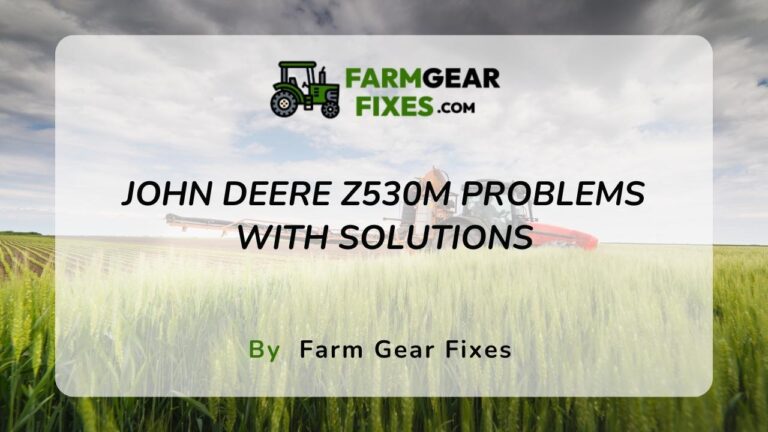6 Common John Deere 4100 Problems (Solutions Included)

Are you facing issues with your John Deere 4100 tractor? You’re not alone. Despite its reputation for reliability, the 4100 model can still experience its fair share of problems. From engine issues to electrical malfunctions, understanding and addressing these challenges is crucial to keeping your tractor in optimal condition.
In this informative blog post, we will discuss common problems that John Deere 4100 owners may face and provide practical solutions to help you get your tractor back up and running efficiently.
Whether you’re a seasoned owner or a first-time buyer, this guide will arm you with the knowledge needed to tackle any issue that may arise with your John Deere 4100.
Common Mechanical Issues and Solutions
Before diving into the common mechanical issues and solutions of the John Deere 4100, it’s important to note that regular maintenance and proper operation can significantly reduce the occurrence of these problems.
However, even with the best care, issues can still arise. In this chapter, we will discuss some of the most common mechanical problems and provide practical solutions to help keep your John Deere 4100 running smoothly.
1) Engine Problems
Issues with the engine of the John Deere 4100 can manifest in various ways, including starting problems, loss of power, or excessive smoke from the exhaust. One common cause of these symptoms is a clogged air filter, which can restrict airflow to the engine.
Regularly inspecting and replacing the air filter can help prevent these issues. Additionally, fuel quality and contamination can also impact engine performance. Ensuring that you are using clean, high-quality fuel and regularly changing the fuel filter can help mitigate these problems.
2) Transmission and Drive Train Problems
Problems with the transmission and drive train of the John Deere 4100 can be a major headache for owners. Common issues include difficulty shifting gears, noisy operation, and loss of power to the wheels. One potential cause of these problems is low or dirty transmission fluid.
Regularly checking and changing the transmission fluid, as well as inspecting for any leaks can help prevent these issues. Additionally, worn or damaged drive belts can also impact the performance of the transmission and drive train.
Inspecting and replacing drive belts as needed can help maintain the proper functioning of these critical components.
It is crucial to address any transmission and drive train issues promptly to prevent further damage and costly repairs. By staying proactive and addressing these problems with the appropriate solutions, you can keep your John Deere 4100 operating at its best.
Electrical Problems
Keep your John Deere 4100 running smoothly by addressing any electrical system complications promptly. Electrical issues can cause major disruptions to your equipment’s performance and can often be challenging to diagnose and repair. We will cover some common electrical system problems found in the John Deere 4100 and their corresponding solutions.
3) Faulty Wiring and Connectors
To ensure the proper functioning of your John Deere 4100, it is essential to regularly inspect the wiring and connectors for any signs of wear, corrosion, or damage.
Faulty wiring and connectors can lead to erratic behavior in the electrical system, causing malfunctions in various components of the tractor. It is crucial to address any issues with the wiring and connectors promptly to prevent further damage to the electrical system.
One of the most common problems related to faulty wiring and connectors is intermittent electrical connectivity, leading to sporadic failures in different parts of the tractor.
Regular maintenance and inspection of the wiring and connectors can help prevent these issues and ensure the smooth operation of your John Deere 4100. It is important to use high-quality connectors and proper wiring techniques to minimize the risk of encountering wiring and connector-related problems.
4) Battery and Charging System Failures
One of the most critical components of the electrical system in the John Deere 4100 is the battery and charging system. Issues with the battery and charging system can lead to starting problems, loss of power, and other electrical malfunctions.
Regularly inspect the battery for signs of corrosion, leakage, or damage, and ensure that the charging system is functioning correctly to avoid potential failures.
Connectors, voltage regulators, and alternators are common points of failure in the battery and charging system of the John Deere 4100. Proper maintenance and timely replacement of these components can help prevent serious electrical system complications and ensure the reliable performance of your equipment.
Hydraulic and PTO Concerns
Unlike other tractors, the John Deere 4100 may experience various issues with its hydraulic and power take-off (PTO) systems.
These concerns can greatly affect the productivity and efficiency of the tractor. Owners and operators need to be aware of these problems and their potential solutions.
5) Hydraulic System Leaks and Pressure Loss
Loss of hydraulic fluid and pressure within the system can lead to decreased performance and functionality of the tractor. Common causes of hydraulic system leaks and pressure loss include damaged seals, hoses, or fittings, as well as worn hydraulic components.
It is crucial to regularly inspect the system for any signs of leaks and address them promptly to prevent further damage. Additionally, maintaining the proper hydraulic fluid levels and using the recommended fluid type can help prevent these issues from occurring.
6) Power Take-Off (PTO) Malfunctions
To ensure the smooth operation of PTO-driven implements, the PTO system needs to function properly. Malfunctions such as PTO slippage, engagement problems, or unexpected disengagement can hinder the tractor’s ability to power external implements.
These issues can be caused by worn PTO components, improperly adjusted PTO clutch, or electrical faults. Regular maintenance and inspection of the PTO system can help identify and address these malfunctions before they escalate.
It is crucial to address any PTO malfunctions promptly to prevent further damage to the system and ensure the tractor’s continued functionality. Regular greasing and lubrication of PTO components, as well as following proper engagement and disengagement procedures, can help prevent PTO malfunctions from occurring.
Maintenance Best Practices
Not maintaining your John Deere 4100 properly can lead to a range of mechanical problems and breakdowns. By following some simple maintenance best practices, you can avoid these issues and ensure that your tractor runs smoothly for years to come.
Routine Service Checklist
Maintenance should always be a top priority when it comes to your John Deere 4100. Establish a routine service checklist and make sure to adhere to it strictly. This should include regular oil changes, filter replacements, and inspections of the engine, cooling system, and hydraulic system.
Keeping up with routine maintenance will prevent small issues from turning into major problems, saving you time and money in the long run.
Preventative Measures and Tips
One of the best preventative measures you can take is to keep an eye out for any signs of wear and tear. Regularly inspect the tires, belts, and hoses for any signs of damage or deterioration.
Additionally, make sure to keep the tractor clean and properly lubricated to prevent dirt and debris from causing damage. Assume that regular maintenance will extend the life of your John Deere 4100 and keep it running at peak performance.
- Inspect tires, belts, and hoses regularly
- Keep tractor clean and well-lubricated
For instance, routinely checking and adjusting tire pressure and monitoring coolant levels can help prevent common issues such as uneven tire wear and overheating. By following these preventative measures, you can ensure that your John Deere 4100 remains in top condition, minimizing the risk of unexpected problems arising.
- Tire pressure
- Coolant levels
Conclusion
Upon reflecting on the common problems encountered with the John Deere 4100, it is clear that certain issues such as overheating, starting problems, and hydraulic leaks can be frustrating for owners. However, there are several solutions available to alleviate these concerns.
By regularly maintaining the cooling system, checking the battery and starter, and inspecting and replacing any worn hydraulic seals, owners can prevent and address these issues effectively.
John Deere 4100 owners need to stay proactive in their maintenance efforts to ensure their equipment operates smoothly and efficiently. By following these solutions, owners can mitigate these common problems and enjoy the reliable performance of their John Deere 4100.






